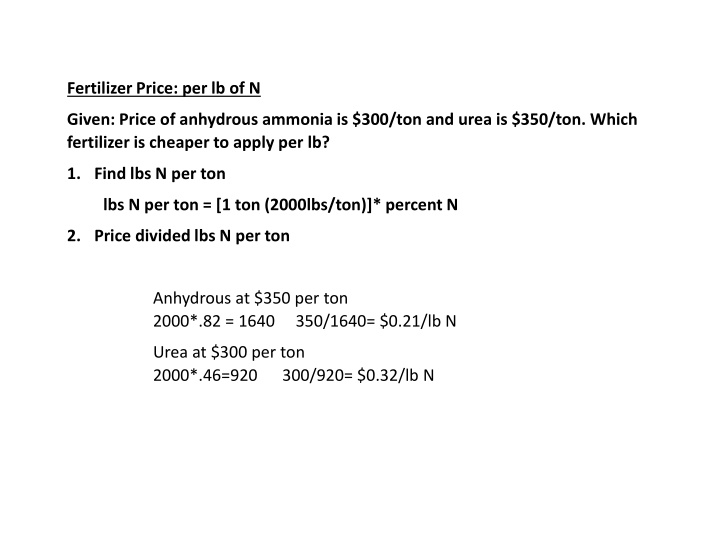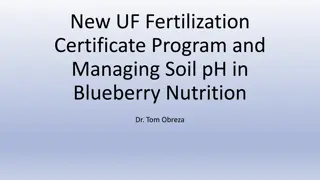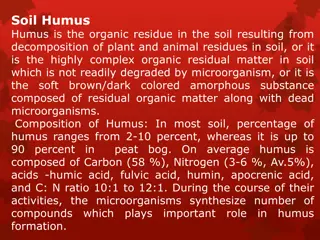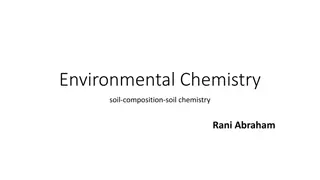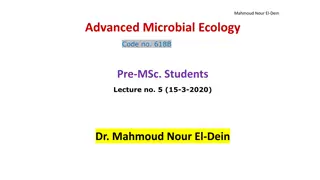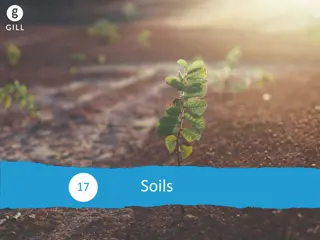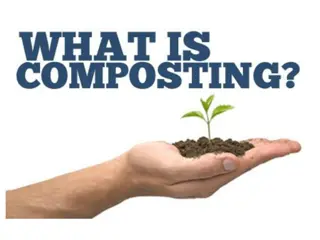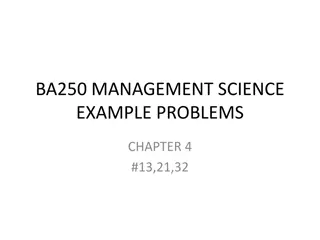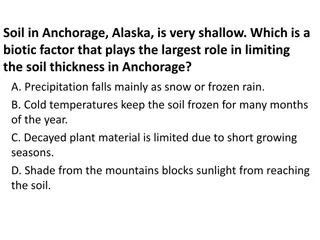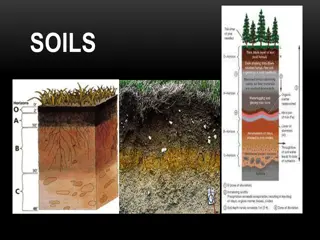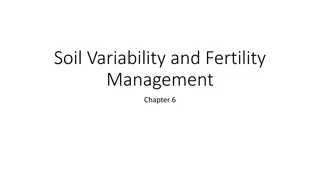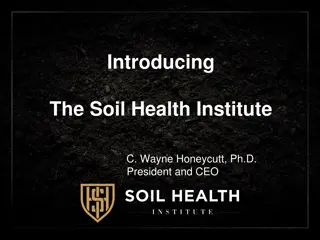Fertilizer Application and Cost Analysis for Soil Nutrients
This detailed agricultural analysis discusses the cost-effectiveness of applying anhydrous ammonia versus urea based on nitrogen content per pound, provides recommendations for nitrogen rates based on yield goals and soil analysis, calculates pounds of nutrients and fillers in a fertilizer blend, and determines the amount of urea, TSP, and MOP required to fulfill a soil test report calling for 120-80-95 lbs of N, P2O5, and K2O per acre. The total cost of the fertilizer blend is also calculated based on the prices of urea, TSP, and MOP per ton.
Download Presentation

Please find below an Image/Link to download the presentation.
The content on the website is provided AS IS for your information and personal use only. It may not be sold, licensed, or shared on other websites without obtaining consent from the author.If you encounter any issues during the download, it is possible that the publisher has removed the file from their server.
You are allowed to download the files provided on this website for personal or commercial use, subject to the condition that they are used lawfully. All files are the property of their respective owners.
The content on the website is provided AS IS for your information and personal use only. It may not be sold, licensed, or shared on other websites without obtaining consent from the author.
E N D
Presentation Transcript
Fertilizer Price: per lb of N Given: Price of anhydrous ammonia is $300/ton and urea is $350/ton. Which fertilizer is cheaper to apply per lb? 1. Find lbs N per ton lbs N per ton = [1 ton (2000lbs/ton)]* percent N 2. Price divided lbs N per ton Anhydrous at $350 per ton 2000*.82 = 1640 350/1640= $0.21/lb N Urea at $300 per ton 2000*.46=920 300/920= $0.32/lb N
Nitrogen Rate Recommendation = yield goal - residual soil N. e.g. Soil analysis from SWFAL was 10 lb N/ac yield goal for wheat is 60 bu/ac Thus: N needs (lb/ac) = 125 lb/ac Nitrogen rate recommendation = 125 10 = 115 lbs N/ac Fertilizer Recommendation (How much fertilizer to apply?) Fertilizer recommendation = N rate divided %N of material e.g. a. Apply 100 lbs N/ac using urea as fertilizer source 100/.46 = 217 lbs Urea b. Apply 200 lbs N/ac using anhydrous as fertilizer source 200/.82 = 244 lbs Anhydrous per acre
For the fertilizer shown in the photo below, how many pounds of N, P2O5, and K2O are there? How many pounds of filler are there?
Pounds of nutrient (N, P2O5, K2O) = (weight) x (fertilizer rate/100) Step 1: Pounds of N = (14) x (22/100) = 3.08 Pounds of P2O5 = (14) x (3/100) = 0.42 Pounds of K2O = (14) x (14/100) = 1.96 Step 2: 3.08 + 0.42 + 1.96 = 5.46 lbs of nutrients Step 3: 14 5.46 = 8.54 lbs fillers
A soil test report calls for 120-80-95 lbs of N, P2O5 and K2O per acre. You have 20 acres that need to be fertilized. If the source of N is urea, source of P2O5 is TSP, and the source of K2O is muriate of potash, how many pounds of each fertilizer must you blend together to fill the truck going to the field? Amount of fertilizer = recommended rate /(fertilizer rate/100) Urea = 120/(46/100) = 260.87 lbs/ac* 20 TSP = 80/(46/100) = 173.91 lbs TSP/ac * 20 = 3,478 lbs TSP MOP = 95/(60/100) = 158.33 lbs MOP/ac * 20 = 3,167 lbs MOP = 5,217 lbs urea
If urea cost $367/ton, TSP at 303/ton, MOP at $307/ton. How much is the total cost of the fertilizer 5,217 lbs/2000 lbs = 2.6085 * 367 = $957.32 3,478 lbs/2000 lbs = 1.739 * 303 = $526.92 3,167 lbs/2000 lbs = 1.5835 * 307 = $486.13 Total cost = 957.32 + 526.92 + 486.13 = $1,970.37
Same soil test report (120-80-95) but your source of fertilizer is DAP, urea, and MOP. How much of each fertilizer is needed in an acre? Amount of fertilizer = recommended rate /(fertilizer rate/100) Step 1 a. Amount of DAP = 80/(46/100) = 173.91 lbs/ac DAP b. Amount of N in DAP = 173.91 * (18/100) = 31 lbs c. Remaining N needed = 120 31 = 89 lbs N Step 2 Amount urea = 89/(46/100) = 193.47 lbs/ac urea Step 3 Amount MOP = 95/(60/100) = 158.33 lbs/ac MOP
